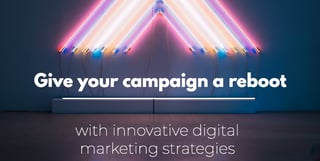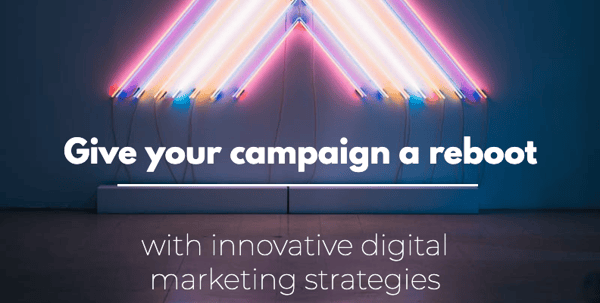Give your campaign a reboot with innovative digital marketing strategies


Keywords, content, bots, AI! If you’ve ever felt that digital marketing is changing at such a rapid pace that you can’t keep up—you’re not alone. In Adobe’s 2013 Digital Distress Survey, 76% of those asked felt that “Marketing had changed more in the past 2 years than in the previous 50.” And the digital marketing engine has only revved up since then. With so many best practices, disruptive strategies, and self-proclaimed experts all touting the latest big trend turning marketing on its head, how do you keep your digital marketing campaign strategy innovative, fresh, and—most importantly—driving results?
For a lot of businesses we work with, keeping up with the changing digital times feels impossible, and they look to us for guidance. It’s not that they’re still putting up billboards or relying on a cold-calling sales strategy, they feel like they’re just getting into a rhythm with all-things Inbound: create a content offer, put it behind a form, write a blog post with the right keywords and a CTA, push out a few social posts, and follow up with leads as they come in. Even those who have adopted the inbound methodology have to keep up with the ever-changing landscape of the internet and how it affects the way people make decisions and purchases. In the last few years, we’ve seen that topics matter more than keywords, forms are friction, and shoppers don’t want to wait around for someone to get back to them--they want answers now, they want high-value content, and they’re not really checking their email like they used to.
If your digital marketing campaign strategy relies on the best practices of even five years ago, you’re significantly behind the times. And it’s hurting your business. That’s why we make it a practice to be on the cutting edge of digital media and business--and we’re dedicated to helping businesses stay at the top of their game to compete and win online.
Let’s talk about some quick wins and long-term strategies to help reboot your digital marketing campaigns.
Quick wins
If you’ve ever been to the doctor for an infection or injury, after diagnosis of the problem, the doctor then prescribes remedies. Let’s say you have a sinus infection. The doctor will prescribe an antibiotic to fight the infection, but he may also prescribe some steroids to help with the inflammation and/or recommend a high dosage of over-the-counter NSAIDs to help the inflammation and pain. While the ibuprofen won’t heal the infection, it will fight some of the effects of the infection that are causing you pain while the antibiotic goes to work over several days fighting the actual problem. Think of quick wins for campaigns like a temporary pain reliever while the strategies are the antibiotic fighting the real problem.
If your campaign is lackluster, behind the times, or just hitting a plateau, you may need some serious internal work to get things back on track. However, that doesn’t mean there are not ways to alleviate some of that poor campaign performance right away while you dig into the bigger work ahead. With quick wins, you need to diagnose problems and identify the long- and short-term strategies to reach your goals.
Here is a brief list of quick wins based on standard campaign needs. Implement some of these wins while you work on the bigger goals and campaign issues that may take longer to bear fruit.
Objective: more traffic/site visitors
- Repurpose existing content for blog posts and social messages.
- Create lookalike audiences for paid media (Facebook, LinkedIn) from your current customer lists to bring in visitors similar to your customers.
- Reach out to thought leaders for quotes or ideas to include in your content.
Objective: more leads
- Install pop-up forms.
- Add CTAs to high-traffic pages.
- Review forms; look for friction and see how you can reduce it.
- Build an easy, straight-forward bot to start qualifying leads.
- Turn existing blog posts into content offers.
- Turn old webinar recordings into on-demand content offers.
- Audit your website for conversion point opportunities.
- Track video usage and add CTAs to your videos.
Objective: more customers
- Get an email out! Associate a person with a cookie to start building and tracking data.
- Activate sales notifications for returning customers.
- Install conversations on high-value pages.
- Build a basic lead scoring system.
- Create quick BOFU offers- think about the last point someone will have to go through before talking to sales.
- Retarget current customers.
- Dig into your database; determine if there are people in your existing database that are valuable.
- Ask for testimonials and reviews from current customers.
Long-term strategies
These are the quick wins to get you started, but you’ll also need to take a step back and see the big picture. What initiatives can you go after for a kick-ass campaign? Here are some of the current trends in digital marketing that use innovative strategies to bring dull campaigns to life and drive results. Implementing these three key strategies can serve as building blocks for a successful business even as things continue changing in the future.
Growth Stack
Thanks to the Internet, there’s a lot of information out there. A LOT. That’s good and bad. While there is plenty of educational content out there, there is also a lot of misleading information. I see business owners get stuck on a particular tactic they read about online that promises overnight success or is what all the experts swear by. The problem is (aside from the fact that anyone can claim to be an expert these days but rarely is), these tactics, even if valid, are only part of the story. You can’t chase after one tactic and expect overnight success. As our managing partner Eric Pratt says,
“If you want to grow your business by leveraging the power of the internet, you're committing to building a sales machine. A big, digital sales engine that works while you're sleeping. It's bigger than your sales team. It's bigger than your marketing team. When developed correctly, it's a completely connected combination of all the latest capabilities, working together towards a common goal.”
Businesses who want to compete in the digital world can’t rely on a single team or tactic alone. You need a full growth stack. Your growth stack is your set of strategies, technologies, and people that work together in a cohesive sales and marketing system.
Without a growth stack, your marketing strategy can’t effectively make a difference in the results of your business. With a growth stack, you’re arming your business to be a growth machine—each team, technology, and tactic all working in different areas toward the same goal.
Conversational marketing
Conversational marketing is delivering the right message to the right person at the right time. We know the way buyers shop has changed--for consumers and businesses alike. Sales people are no longer the gatekeepers of information; buyers are in the driver’s seat. Conversational marketing leverages this shift in the buying process and converts at a rate five times higher than traditional conversion sources. Even if you don’t know what conversational marketing is, chances are you’ve probably already encountered it. Tools in a conversational marketing strategy include chatbots, live chat, even a calendar tool that allows you to schedule a meeting with someone in real-time (not all that “what works for you” back and forth). The key to all of these tools comes down to meeting your customers in their time, not yours. To get started with this digital marketing strategy and execute it effectively, you’ll need to build your conversational marketing blueprint that maps out:
- What conversations will take place?
- What questions will people have or what information are they seeking
- Where will these conversations happen on your website?
- Home page, product page, support page, etc
- With whom with you be having these conversations?
- First-time visitors, returning leads, customers, etc
No digital marketing strategy in 2019 is complete without conversational marketing. This is an effective strategy that benefits every stage of the buyer’s journey from answering a prospect’s question to scheduling a demo with a salesperson to delighting a customer with real-time support.
Pillar pages + topic clusters
We’ve been hearing about pillar pages for a few years now, but a surprisingly few number of businesses have actually implemented the strategy. I remember when I first read Anum Hussain’s post on Topics Over Keywords back in 2015 where she proposed an SEO-driven approach to content marketing. I also remember the day two and a half years later when HubSpot announced it would be sunsetting its Keywords tool. And I remember the uproar from many who didn’t understand why HubSpot would ditch a tool so key to digital marketing.
But what’s replaced the keywords tool is content clusters (now known as the SEO tool) in HubSpot. As search engines grow more intelligent, we don’t need to match exact keywords or phrases to rank on SERPs. We need topic authority and a lot of it.
We need to convince search engines and users that we have the answers they’re looking for. When Anum’s team first started digging into this theory, they called them “10X Site Pages,” pages on your website that would cover comprehensive information on a topic. Now, we know them as pillar pages, but the idea stands--and the data continues to prove its value. Linking new content to historical blog posts on the same topic not only helps the SEO value of the new content but also improves the organic performance of the historical posts. Then, when linked to the central pillar page performance grows across the board.
To get started with a pillar page and clustering strategy, choose a topic relevant to your business and audience that you want to become the authority on. You can either use existing content or start fresh writing long-form, comprehensive content on that chosen topic. Then, start linking to shorter-form content covering subsets of that topic. Developing content clusters around a central pillar page is a vital part of a digital marketing strategy today.
Try some quick wins and start implementing these key digital marketing strategies to give your campaign a reboot and start seeing valuable results.

